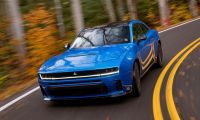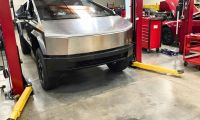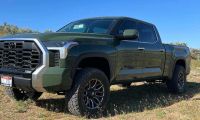The refreshed Model S & X incorporate the boldest design change in Tesla’s history, at least since the EV maker unveiled the Model 3 without an instrument cluster back in 2016.
Since the new Model S & X started customer deliveries back in 2021, the vehicles have been met with unanimous admiration for their tech and performance.
The tech in the new Model S & X is on par with the highest-end luxury vehicles if not considerably better. The new vehicles come standard with an AMD GPU which is similar to the one found on the PlayStation 5.
The new Model S & X also have active noise cancelation where microphones in the vehicle emit sound waves that cancel out road noise giving the vehicle a quiet luxurious drive.
Related News: Model 3 Now Starts at $26,950 After Tesla Found a Loophole for All Model 3 Variants to Get Full $7,500 Tax Credit
And when it comes to performance that is where the 2 vehicles shine. Especially the Model S Plaid which has been setting world records as the first production vehicle that can go 0 to 60 miles per hour in under 2 seconds. According to Elon Musk, the Model S Plaid accelerates 20% quicker than gravity.
Adding to the incredible performance of the Model S Plaid, in January of this year, Tesla added Track Mode to the vehicle. Track Mode is Tesla’s proprietary software that enables the EV maker’s sedans to unleash their full potential on the track.
Introducing the feature Tesla wrote “Plaid Track Mode is rolling out to Model S Plaid vehicles across North America. With Plaid Track Mode our goals were simple: achieve the quickest lap time for a production electric vehicle at Germany’s Nürburgring, and allow individual adjustability of stability control, handling balance, and regenerative braking to give drivers more authority over vehicle control at the racetrack.”
And Tesla goes into detail about every feature of the Plaid Track Mode: and these include…
Optimized Powertrain Cooling
Track driving generates an enormous amount of heat in the battery, motors, and brakes. Maximum track endurance is achieved by managing this heat to keep these components as cool as possible.
When Plaid Track Mode is engaged, we drop the temperature of the battery pack and motors to create a significant amount of chilled thermal mass. Once track driving begins and heat is generated, shared coolant loops between the battery and motors keep the entire system cooler for longer.
We also increase regenerative braking power, which has three major benefits: re-capture more energy during deceleration, reduce the load on the friction brakes for better thermal management, and give the driver better modulation and controllability with a single pedal.
Lateral Torque Vectoring
Using the same foundation as Model 3 Track Mode, Plaid Track Mode relies heavily on front and rear motors to command rotation: additional torque applied to the rear axle helps turn the nose of the car into a corner; torque applied to the front axle arrests rotation to pull the car straight.
Building on this principle, Model S Plaid’s dual rear motors enable full lateral torque vectoring. With Track Mode activated, Plaid automatically adjusts torque split across the rear wheels, independently, which applies a torque bias to rotate the car through turns; this increases turn-in response, improves on-center steering feel, and delivers even greater yaw control throughout a corner.
Compared to traditional open- and limited-slip differentials, which must always compete between turn-in response and maximum traction, our electric motors adjust in milliseconds to give the driver both strengths simultaneously, allowing for faster turn-in, increased cornering speeds, and harder acceleration on corner exit.
Adjustable Vehicle Dynamics
During normal road driving, our stability control systems are optimized to limit tire slippage and maximize grip to keep the driver safe.
In Plaid Track Mode, stability controls enter a race tuning to give the driver maximum control over the car’s lateral movement. With Plaid Track Mode engaged, Tesla’s Vehicle Dynamics Controller (VDC) evaluates steering angle, accelerator, and brake pedal inputs to determine where the driver wants to place the car and will permit tire slippage and automatically adjust torque split to give the driver even more authority and improved agility during high-speed cornering.
For drivers who want additional adjustability over vehicle dynamics, handling balance, stability assist, and regenerative braking can be changed independently based on their skill level and preferences.
Adaptive Suspension Damping
When Plaid Track Mode is engaged, adaptive suspension damping is optimized for track handling: reduced pitch during hard braking and fast acceleration, rebalanced damping to improve responsiveness, and faster settling of vehicle disturbances over bumpy segments to increase driver confidence. To facilitate consistent dynamic driving, ride height is set to Low on drive-off, and the suspension will no longer automatically raise to improve comfort.
Performance UI
We have added a track-focused user interface to provide critical performance data, including a vehicle thermals monitor, lap timer, G-meter, dashcam video capture, and vehicle telemetry, along with several other customizable options.
These are all exciting, however, to unleash the Model S Plaid’s full potential, Tesla also offers a track pack that costs between $15,000 and $20,000. The Plaid track pack includes improved carbon-ceramic brakes, new racing tires and aluminum forged lighter wheels.
With all the software improvements coming with Track Mode and hardware improvements coming with the track pack, the Model S can hit its stated top speed of 200mph in addition to the ability to do repeated runs at the track.
Having worked on all these additional features, yesterday, Tesla took the Model S Plaid with the track pack to the Nurburgring. And the vehicle did not disappoint breaking the EV production lap record at the track.
The Model S Plaid with the track pack completed a lap around Nurburgring in 7:25.231. This is 8 seconds faster than the previous production EV record holder which was the Porche Taycan Turbo S.
Tesla announced this feat on the company’s official Twitter page and shared a picture of a couple of Model S Plaids and the race drivers that set the new record.
It is nice to see Tesla back at the top of the highest-performance production EV list however, this might just be the beginning. Although a 7:25.231 lap time at Nurburgring is impressive, Elon Musk has previously stated that Tesla’s goal is to lower it to under 7 minutes.
Given the already bleeding-edge technological state of the Model S Plaid, Tesla will need to put in a lot of work if the EV maker plans to make huge improvements such as shaving off 25 seconds from the lap time of the vehicle.
And we will be sure to keep you posted as Tesla works to improve the already remarkable Model S Plaid. Until then, make sure to visit our site torquenews.com/Tesla regularly for the latest updates.
So what do you think? Excited about the Tesla Model S reclaiming its spot at the top of the production EV performance list? Also, what do you think about all the new features coming with Track Mode on the Model S Plaid? Let me know your thoughts in the comments below.
Image: Courtesy of Tesla, Inc.
For more information check out: Norway: 80% Share of Electric Vehicles Despite End of Tax Breaks; Tesla Model Y Leading
Tinsae Aregay has been following Tesla and The evolution of the EV space on a daily basis for several years. He covers everything about Tesla from the cars to Elon Musk, the energy business, and autonomy. Follow Tinsae on Twitter at @TinsaeAregay for daily Tesla news.












